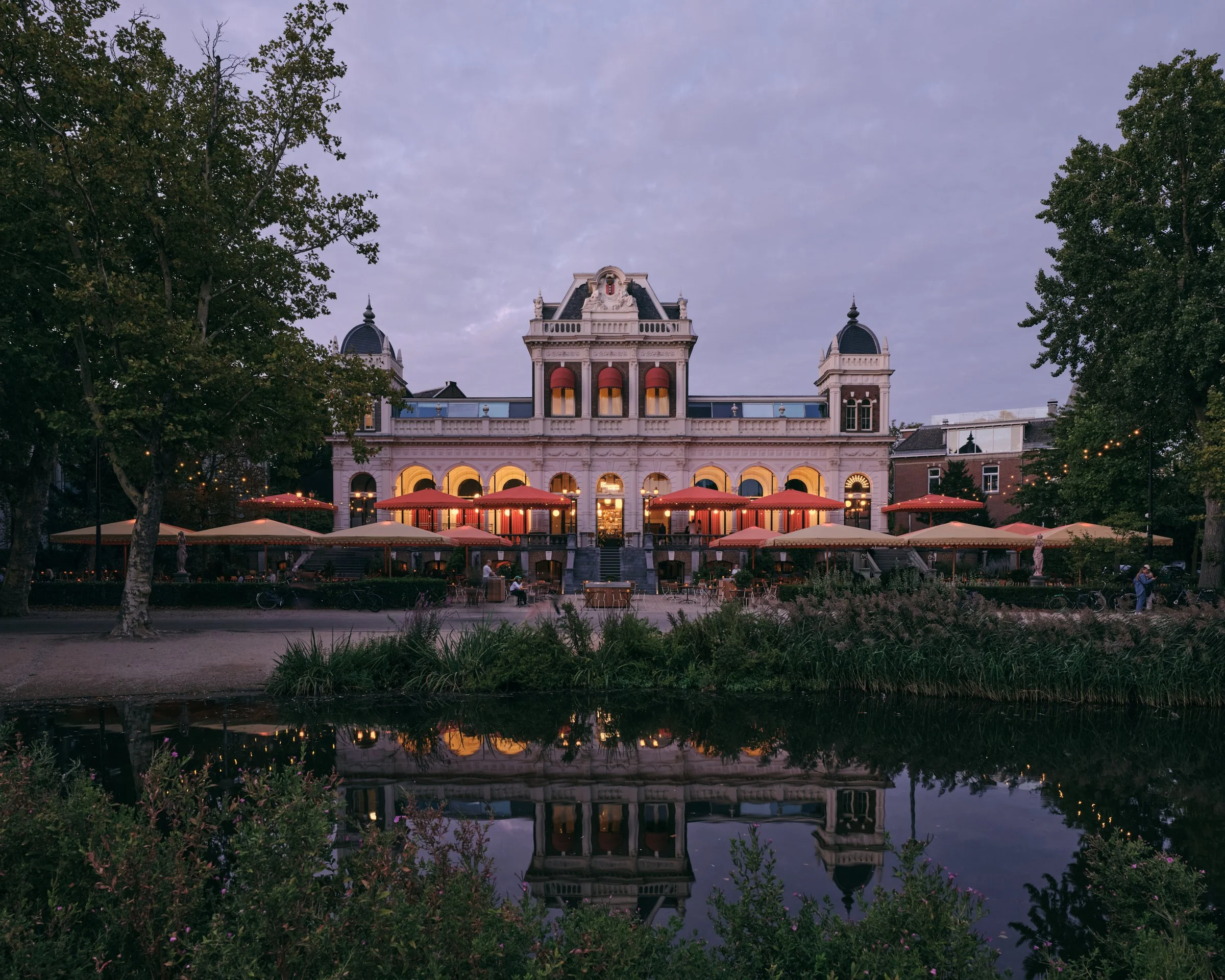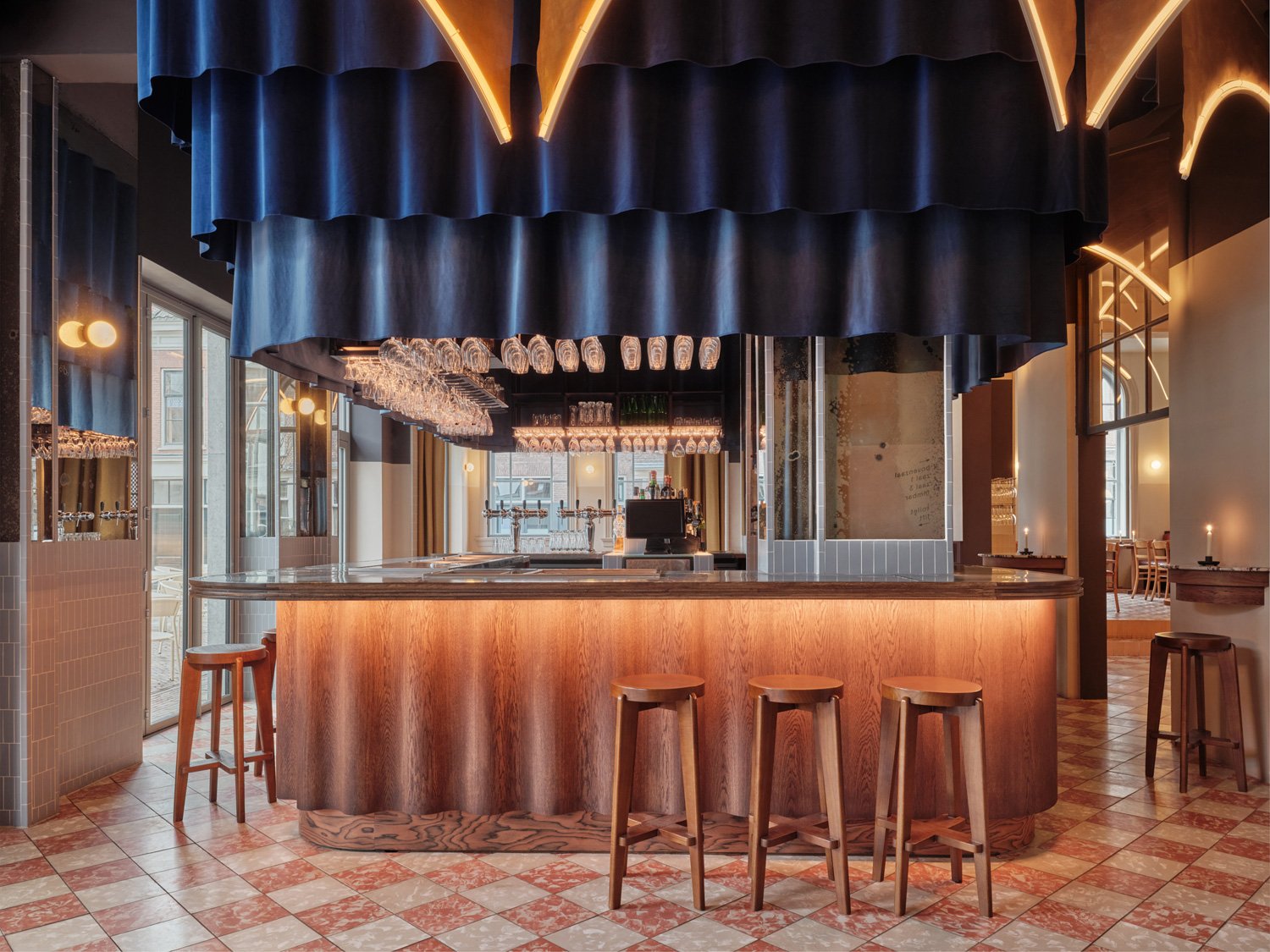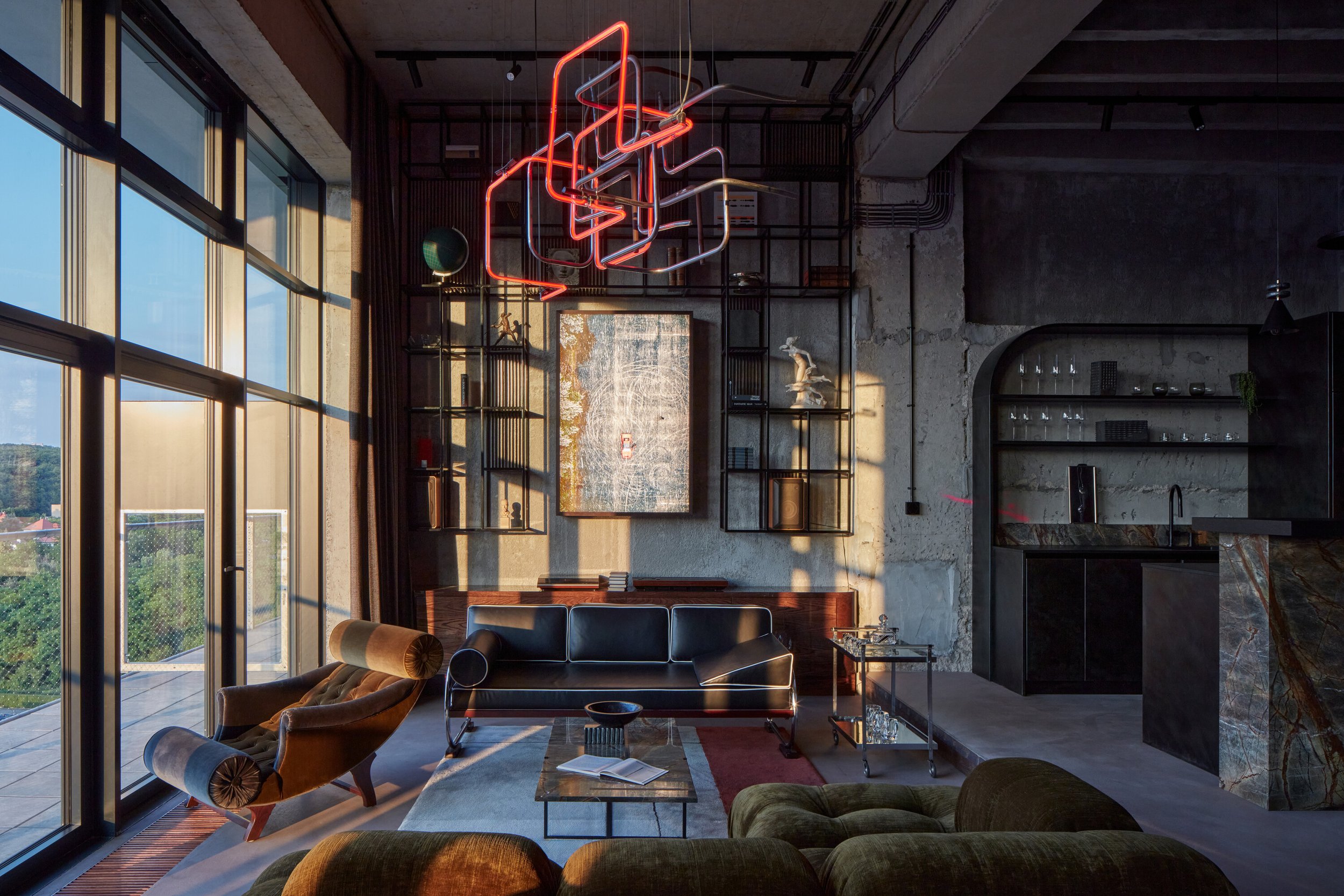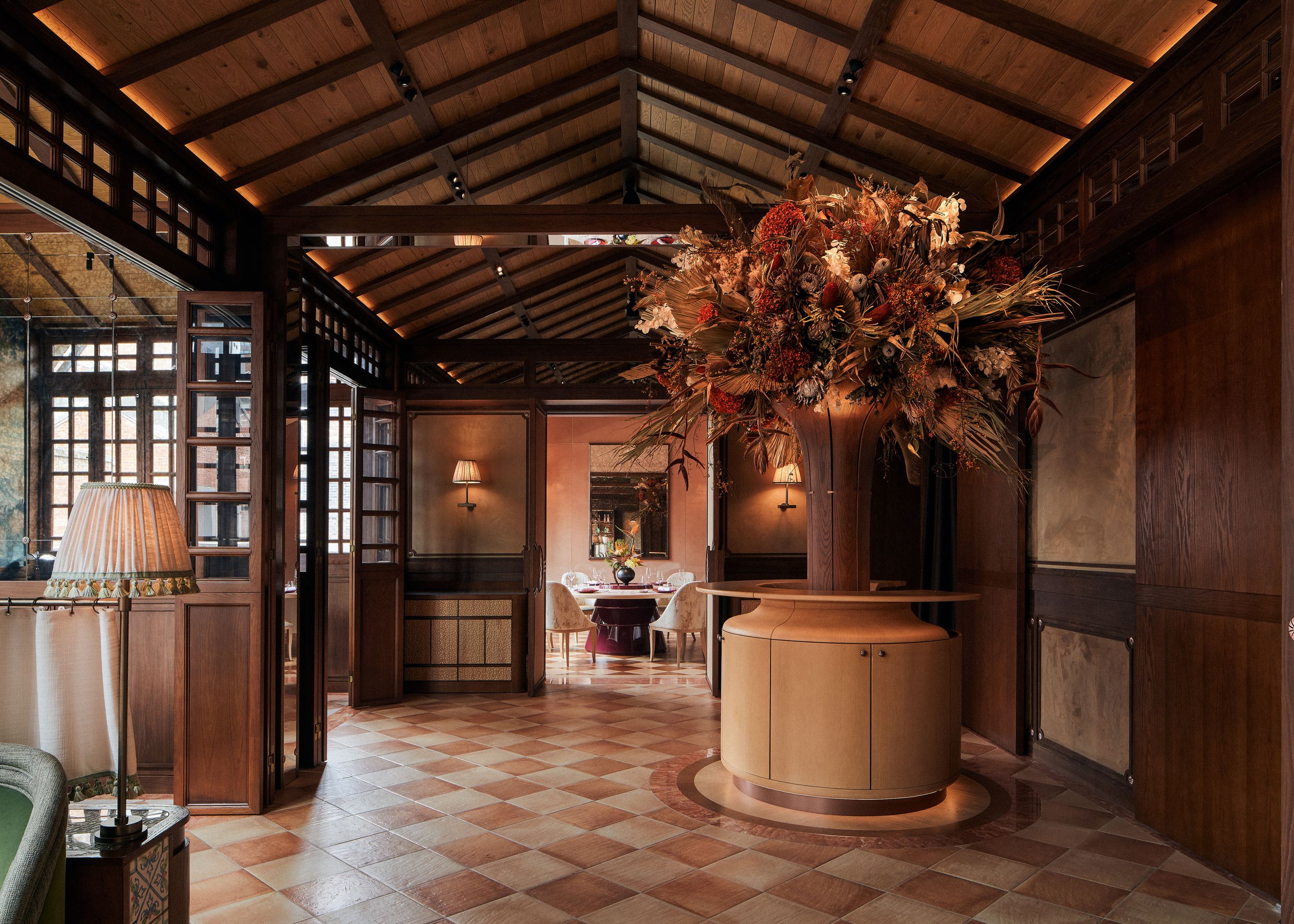CAFÉ VERTIGO || Hitchcock-Inspired Design Revives Amsterdam’s Vondelpark Pavilion

In Vondelpark’s historic pavilion, time folds like a reel of film spliced together.
Café Vertigo, redesigned by Studio Modijefsky, embraces this layered past with a cinematic sensibility drawn from Hitchcock’s Vertigo. Here, disorienting lines, velvet-draped arches, and glowing orbs echo both the glamour of the building’s nightclub years and the elegance of its Renaissance-inspired architecture, offering a setting that is at once historic and thrillingly new.
The main bar area acts as a gravitational centre, drawing visitors in with its sculptural presence and layered materiality.
The Vondelpark Pavilion, designed by Willem Hamer Jr. in the late 19th century, has long been a cultural anchor for Amsterdam. Over the decades, it has transformed from a grand restaurant to a dance club, a barber shop, the International Cultural Centre, and even the city’s Filmmuseum. Its souterrain was once the infamous Kiekeboe nightclub, remembered for mirrored walls and an all-pink interior that became a creative hub of the 1970s. Rather than erasing these identities, Studio Modijefsky chose to reinterpret them, layering fragments of history into a contemporary composition that keeps the building alive for a new generation.
Café Vertigo unfolds as a sequence of cinematic scenes, each designed to play with perception. Perspective lines on walls, floors, and ceilings draw the eye forward, subtly disorienting visitors as they move from one zone to the next. The souterrain is wrapped in plush velvet and faceted mirrors, recalling the backstage glamour of old film sets and the sensual intimacy of historic nightclubs. Upstairs, a glossy purple lacquered bar asserts itself as a theatrical centrepiece against the pavilion’s classical arches. In the winter garden, floor-to-ceiling coral curtains bathe the space in warm light, visually echoing the parasols scattered across the terrace outside. Every surface, every gesture, is a careful negotiation between history and imagination.
In the alcoves, light fixtures echo vintage shower heads, referencing the building’s early bathroom details while framing intimate dining scenes. Artwork by Indigo Sum and Lotus Krabbé adds colour and depth to tiled alcoves, weaving cinematic tones into the café’s layered palette.
Spatial choreography defines the guest experience. The bar serves as the gravitational center, while surrounding areas offer a range of moods: sunken nooks for hushed conversation, alcoves wrapped in velvet for intimate dining, and elevated seating that frames views across the pavilion. Materials shift between zones to reinforce the atmosphere. Zellige tile meets timber, velvet contrasts with plaster, and brass details glint against marble. The result is an interior that feels in motion, like a film sequence cut from multiple perspectives yet woven into a single story.
Velvet-lined arches in the souterrain set the stage for Café Vertigo’s cinematic narrative, blending nightclub intimacy with the grandeur of historic architecture.
Lighting becomes another character in this narrative. In the booth alcoves, sconces curve like vintage shower heads, recalling the building’s original bathroom tiles. Tiffany-style glass lamps cast a nostalgic glow over tiled walls, while orb fixtures float above dining wings like studio lights waiting to illuminate a stage. At night, a wave of glowing spheres hovers over the terrace, guiding the eye toward the pavilion and inviting passersby to enter the scene.
Art amplifies the cinematic mood. A reflective mobile by Bregje Sliepenbeek catches shards of light above a booth, while works by Indigo Sum and Lotus Krabbé echo the café’s red and coral palette. Pieces by Jesper Dobbeling, Vincent de Boer, and Annelot de Boer weave in references to cinema and Amsterdam’s cheeky creative spirit. Together, these interventions create a gallery-like dimension, tying contemporary expression to the layered cultural memory of the site.
Inspired by iconic cinema and urban storytelling, the art reveals itself as a layered tribute to the indomitable power of creativity.
Outside, the terrace extends the performance into Vondelpark itself. Two levels offer two different atmospheres: a lively park terrace for casual meetups and aperitifs, and an elevated balcony for linen-clad dining above the treetops. Parasols in hues of papaya red, soft orange, and daffodil yellow bridge the greenery of the park with the architectural formality of the pavilion. Whether catching the afternoon sun or lingering into golden hour, the terrace positions Café Vertigo as one of the city’s most atmospheric outdoor dining experiences.
The elevated terrace offers a bistro-like atmosphere overlooking Vondelpark, bridging the greenery of the park with the elegance of the pavilion.
Ultimately, Café Vertigo is not just a design intervention; it is a cultural revival. By weaving together Hitchcock-inspired illusions with echoes of the pavilion’s layered history, Studio Modijefsky has crafted a destination where past and present blur. It is a place that honors its heritage while staging new stories, reminding Amsterdammers that some landmarks are too vital to fade into memory.
PROJECT DETAILS
Project: Café Vertigo
Location: Amsterdam, Netherlands
Program: Bar, Café & Restaurant
Assignment: Interior design
Status: Finalized July 2025
Size: 350 m2 interior/ 660 m2 exterior
Design: Studio Modijefsky; Esther Stam, Kathryn Mallory, Beau Van der Schoot, Laura de Miranda, Ivana
Stella, Moene van Werven, Julia Banaszewska, Christel Willers
Photography: Maarten Willemstein









